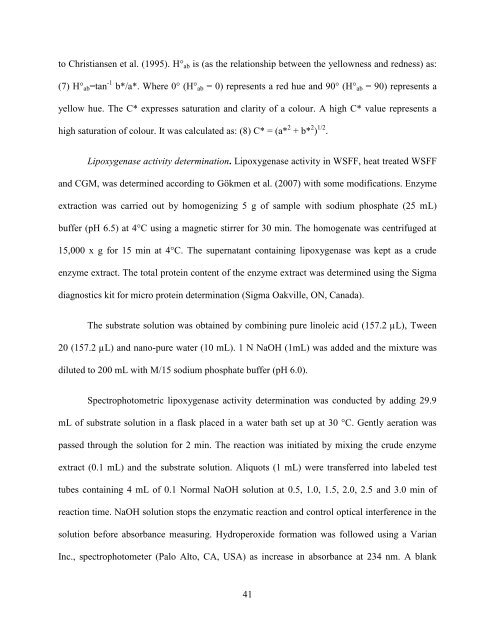Pigment Reduction in Corn Gluten Meal and Its Effects on Muscle ...
Pigment Reduction in Corn Gluten Meal and Its Effects on Muscle ...
Pigment Reduction in Corn Gluten Meal and Its Effects on Muscle ...
You also want an ePaper? Increase the reach of your titles
YUMPU automatically turns print PDFs into web optimized ePapers that Google loves.
to Christiansen et al. (1995). H° ab is (as the relati<strong>on</strong>ship between the yellowness <str<strong>on</strong>g>and</str<strong>on</strong>g> redness) as:(7) H° ab =tan -1 b*/a*. Where 0° (H° ab = 0) represents a red hue <str<strong>on</strong>g>and</str<strong>on</strong>g> 90° (H° ab = 90) represents ayellow hue. The C* expresses saturati<strong>on</strong> <str<strong>on</strong>g>and</str<strong>on</strong>g> clarity of a colour. A high C* value represents ahigh saturati<strong>on</strong> of colour. It was calculated as: (8) C* = (a* 2 + b* 2 ) 1/2 .Lipoxygenase activity determ<str<strong>on</strong>g>in</str<strong>on</strong>g>ati<strong>on</strong>. Lipoxygenase activity <str<strong>on</strong>g>in</str<strong>on</strong>g> WSFF, heat treated WSFF<str<strong>on</strong>g>and</str<strong>on</strong>g> CGM, was determ<str<strong>on</strong>g>in</str<strong>on</strong>g>ed accord<str<strong>on</strong>g>in</str<strong>on</strong>g>g to Gӧkmen et al. (2007) with some modificati<strong>on</strong>s. Enzymeextracti<strong>on</strong> was carried out by homogeniz<str<strong>on</strong>g>in</str<strong>on</strong>g>g 5 g of sample with sodium phosphate (25 mL)buffer (pH 6.5) at 4°C us<str<strong>on</strong>g>in</str<strong>on</strong>g>g a magnetic stirrer for 30 m<str<strong>on</strong>g>in</str<strong>on</strong>g>. The homogenate was centrifuged at15,000 x g for 15 m<str<strong>on</strong>g>in</str<strong>on</strong>g> at 4°C. The supernatant c<strong>on</strong>ta<str<strong>on</strong>g>in</str<strong>on</strong>g><str<strong>on</strong>g>in</str<strong>on</strong>g>g lipoxygenase was kept as a crudeenzyme extract. The total prote<str<strong>on</strong>g>in</str<strong>on</strong>g> c<strong>on</strong>tent of the enzyme extract was determ<str<strong>on</strong>g>in</str<strong>on</strong>g>ed us<str<strong>on</strong>g>in</str<strong>on</strong>g>g the Sigmadiagnostics kit for micro prote<str<strong>on</strong>g>in</str<strong>on</strong>g> determ<str<strong>on</strong>g>in</str<strong>on</strong>g>ati<strong>on</strong> (Sigma Oakville, ON, Canada).The substrate soluti<strong>on</strong> was obta<str<strong>on</strong>g>in</str<strong>on</strong>g>ed by comb<str<strong>on</strong>g>in</str<strong>on</strong>g><str<strong>on</strong>g>in</str<strong>on</strong>g>g pure l<str<strong>on</strong>g>in</str<strong>on</strong>g>oleic acid (157.2 µL), Tween20 (157.2 µL) <str<strong>on</strong>g>and</str<strong>on</strong>g> nano-pure water (10 mL). 1 N NaOH (1mL) was added <str<strong>on</strong>g>and</str<strong>on</strong>g> the mixture wasdiluted to 200 mL with M/15 sodium phosphate buffer (pH 6.0).Spectrophotometric lipoxygenase activity determ<str<strong>on</strong>g>in</str<strong>on</strong>g>ati<strong>on</strong> was c<strong>on</strong>ducted by add<str<strong>on</strong>g>in</str<strong>on</strong>g>g 29.9mL of substrate soluti<strong>on</strong> <str<strong>on</strong>g>in</str<strong>on</strong>g> a flask placed <str<strong>on</strong>g>in</str<strong>on</strong>g> a water bath set up at 30 °C. Gently aerati<strong>on</strong> waspassed through the soluti<strong>on</strong> for 2 m<str<strong>on</strong>g>in</str<strong>on</strong>g>. The reacti<strong>on</strong> was <str<strong>on</strong>g>in</str<strong>on</strong>g>itiated by mix<str<strong>on</strong>g>in</str<strong>on</strong>g>g the crude enzymeextract (0.1 mL) <str<strong>on</strong>g>and</str<strong>on</strong>g> the substrate soluti<strong>on</strong>. Aliquots (1 mL) were transferred <str<strong>on</strong>g>in</str<strong>on</strong>g>to labeled testtubes c<strong>on</strong>ta<str<strong>on</strong>g>in</str<strong>on</strong>g><str<strong>on</strong>g>in</str<strong>on</strong>g>g 4 mL of 0.1 Normal NaOH soluti<strong>on</strong> at 0.5, 1.0, 1.5, 2.0, 2.5 <str<strong>on</strong>g>and</str<strong>on</strong>g> 3.0 m<str<strong>on</strong>g>in</str<strong>on</strong>g> ofreacti<strong>on</strong> time. NaOH soluti<strong>on</strong> stops the enzymatic reacti<strong>on</strong> <str<strong>on</strong>g>and</str<strong>on</strong>g> c<strong>on</strong>trol optical <str<strong>on</strong>g>in</str<strong>on</strong>g>terference <str<strong>on</strong>g>in</str<strong>on</strong>g> thesoluti<strong>on</strong> before absorbance measur<str<strong>on</strong>g>in</str<strong>on</strong>g>g. Hydroperoxide formati<strong>on</strong> was followed us<str<strong>on</strong>g>in</str<strong>on</strong>g>g a VarianInc., spectrophotometer (Palo Alto, CA, USA) as <str<strong>on</strong>g>in</str<strong>on</strong>g>crease <str<strong>on</strong>g>in</str<strong>on</strong>g> absorbance at 234 nm. A blank41
















